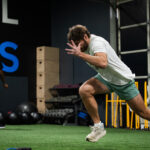Plyometrics for Athletes: Boost Speed and Power
Athletes are always looking for a competitive edge. Whether it’s faster sprints, higher jumps, or better reaction time, performance matters. Plyometrics is a training method designed to improve all of these elements.
This article explains how athletes can use plyometrics to gain speed, strength, and explosive power.
What Makes Plyometrics Ideal for Athletes?
Plyometrics involves fast, explosive movements that mimic actions in many sports. These exercises improve neuromuscular coordination and develop fast-twitch muscle fibers—essential for speed and quick reaction time.
That’s why you’ll see athletes in football, basketball, volleyball, and track all incorporating plyometrics into their training.
Benefits include:
-
Greater sprinting speed
-
Improved vertical jump
-
Enhanced agility and change of direction
-
Reduced injury risk through better joint control
According to the NSCA, plyometric training helps athletes generate more force in less time—essential for explosive performance.
Top Plyometric Exercises for Athletes
These plyometric drills are ideal for developing the kind of athleticism needed on the field or court:
1. Depth Jumps
Start on a box, step off, and explode upward upon landing. Improves reactive strength and vertical power.
2. Bounding
Use long, powerful strides to improve sprint mechanics and leg drive. Great for track and field athletes.
3. Lateral Hops
Quick side-to-side hops boost agility and knee stability.
4. Box Jumps
Jumping onto a stable box helps train explosive lower-body power and coordination.
5. Medicine Ball Slams
Add upper-body plyometrics to develop total-body explosiveness.
Perform these exercises 2–3 times a week, depending on your training load.
Sample Athlete Plyometric Routine
Here’s a quick and effective plyometrics session designed for athletes:
-
Dynamic warm-up – 5 minutes
-
Depth Jumps – 3 sets of 5 reps
-
Box Jumps – 3 sets of 6 reps
-
Lateral Bounds – 3 sets of 20 seconds
-
Bounding (20 meters) – 3 rounds
-
Medicine Ball Slams – 3 sets of 10 reps
-
Cool down/stretching – 5 minutes
This routine focuses on full-body explosiveness and sport-specific movement patterns.
When Should Athletes Use Plyometrics?
Timing is key. Plyometrics should be done when you’re fresh, ideally early in a training session. This ensures maximum effort and correct form.
Use plyometric drills:
-
During preseason to build explosive foundations
-
In-season with lower volume for maintenance
-
Post-injury, under supervision, to rebuild power and stability
Avoid high-volume plyometrics right before a big game or competition, as fatigue can impact performance.
Common Plyometric Mistakes Athletes Should Avoid
Plyometric training is powerful—but only when done right. Watch out for these common errors:
-
Skipping warm-up, which increases injury risk
-
Too much volume, leading to overtraining
-
Poor landing mechanics, causing joint stress
-
Not resting enough, limiting power output
Focus on quality reps and technique. Every jump should be explosive, not sloppy.
How Plyometrics Enhance Sport-Specific Skills
Each sport demands a unique combination of speed, agility, and coordination. Plyometrics bridges the gap between strength training and real-world performance.
-
Basketball: Improves jumping and rebounding
-
Football: Builds sprint power and change of direction
-
Soccer: Enhances footwork and acceleration
-
Track and Field: Optimizes stride power and rhythm
Want to train like an elite athlete? Next Level Athletics USA offers custom programs that combine plyometrics with sport-specific training for game-day performance.
Conclusion: Plyometrics Give Athletes the Edge
Plyometrics is more than just jumping—it’s a science-backed way to enhance speed, power, and agility. For athletes looking to outpace the competition, this type of training is a must.
Incorporate plyometrics into your routine, stay consistent, and watch your athletic performance soar.


Recent Comments